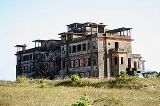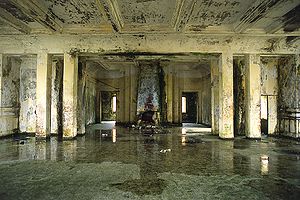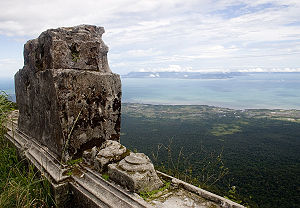
Bokor Hill Station
Encyclopedia
Bokor Hill Station is an abandoned French town in Preah Monivong National Park
. Construction started in 1921 on Dâmrei Mountains
, about 20 km as the crow flies (42 km by the road) West from the town of Kampot, southern Cambodia
. It was used as the location for the final showdown of the movie City of Ghosts
(2002) and the 2004 film R-Point
.
French
settlers to offer an escape from the heat, humidity and general insalubrity of Phnom Penh
. Nine hundred lives were lost in nine months during the construction of the resort in this remote mountain location.
The centrepiece of the resort was the grand Bokor Palace Hotel & Casino, complemented by shops, a post office (now demolished), a church and the Royal Apartments. It is also an important cultural site, showing how the colonial settlers spent their free time.
Bokor Hill was abandoned first by the French in late 1940s, during the First Indochina War
, because of local insurrections guided by the Khmer Issarak
, and then for good in 1972, as Khmer Rouge
took over the area. During the Vietnamese invasion in 1979, Khmer Rouge entrenched themselves and held on tightly for months. In earlier 1990s Bokor Hill was still one of the last strongholds of Khmer Rouge.
 Now abandoned, with the exception of the old post office most of the buildings are still standing. The strategic importance of the location is underlined by the fact that the Cambodian authorities maintain a Ranger Station on the site. The only other "inhabited" building on the site is a small temple. There is also a waterfall which tends to be dry in high season and in full flow during rainy season. About 10 km before on the way for Bokor Hill Station there is the Black Palace. It was a little summer palace of King Sihanouk, abandoned some decade ago.
Now abandoned, with the exception of the old post office most of the buildings are still standing. The strategic importance of the location is underlined by the fact that the Cambodian authorities maintain a Ranger Station on the site. The only other "inhabited" building on the site is a small temple. There is also a waterfall which tends to be dry in high season and in full flow during rainy season. About 10 km before on the way for Bokor Hill Station there is the Black Palace. It was a little summer palace of King Sihanouk, abandoned some decade ago.
 Today the site is beginning to attract significant numbers of tourists. Reaching the top of Bokor Hill previously required a 32 km grind from sea-level to the top of the 3540 ft peak, up an old road that took 1.5 hours to complete. However, as at August 2011, while still being completed, a new sealed road is in use with battered slopes & drainage systems to try & prevent landslides.
Today the site is beginning to attract significant numbers of tourists. Reaching the top of Bokor Hill previously required a 32 km grind from sea-level to the top of the 3540 ft peak, up an old road that took 1.5 hours to complete. However, as at August 2011, while still being completed, a new sealed road is in use with battered slopes & drainage systems to try & prevent landslides.
The site is owned by the government but is now under 99–year lease to the Sokimex Group who are undertaking to relay the road and redevelop the site, repairing the old hotel and casino along with new buildings (hotels, hospital, restaurants, golf clubs etc). The project was announced on Jan 19th 2008, road construction is underway and was expected to take 30 months at a cost of $21 million USD. When visited in August 2011, the hill station was easily accessible to tourists, but only as part of a paid tour group. The subsequent re-development is budgeted at $1 billion USD over the next 15 years after which a further application may be submitted to create a larger Bokor city, the plans for which are unknown.
Preah Monivong National Park
Preah Monivong National Park is a national park in southern Cambodia. The main attraction of the park is Bokor Hill Station. The park is one of only two Cambodian ASEAN Heritage Parks .It is also known as Phnom Bokor National Park...
. Construction started in 1921 on Dâmrei Mountains
Dâmrei Mountains
The Dâmrei Mountains, literally the "Elephant Mountains", are a mountain range situated in the southwest of Cambodia.-Description:These mountains are an offshoot of the Krâvanh or Cardamom Mountains, but occupy a much smaller area. The highest elevation is Phnom Bokor at 1,081 meters above...
, about 20 km as the crow flies (42 km by the road) West from the town of Kampot, southern Cambodia
Cambodia
Cambodia , officially known as the Kingdom of Cambodia, is a country located in the southern portion of the Indochina Peninsula in Southeast Asia...
. It was used as the location for the final showdown of the movie City of Ghosts
City of Ghosts
City of Ghosts is a 2002 drama film co-written, directed by and starring Matt Dillon, about a con artist who must go to Cambodia to collect his share in money collected from an insurance scam...
(2002) and the 2004 film R-Point
R-Point
R-Point is a 2004 Korean horror film written and directed by Su-chang Kong and starring Gam Wu-seong and Son Byung-ho. It is set in 1972 Vietnam, during the Vietnam War. However, most of the movie was shot in Cambodia...
.
History
The town was built as a resort by the colonialColonial Cambodia
In 1863, Cambodia under king Norodom became a protectorate of France. In October 1887, the French announced the formation of the Union Indochinoise , which at that time comprised Cambodia, already an autonomous French possession, and the three regions of Vietnam...
French
France
The French Republic , The French Republic , The French Republic , (commonly known as France , is a unitary semi-presidential republic in Western Europe with several overseas territories and islands located on other continents and in the Indian, Pacific, and Atlantic oceans. Metropolitan France...
settlers to offer an escape from the heat, humidity and general insalubrity of Phnom Penh
Phnom Penh
Phnom Penh is the capital and largest city of Cambodia. Located on the banks of the Mekong River, Phnom Penh has been the national capital since the French colonized Cambodia, and has grown to become the nation's center of economic and industrial activities, as well as the center of security,...
. Nine hundred lives were lost in nine months during the construction of the resort in this remote mountain location.
The centrepiece of the resort was the grand Bokor Palace Hotel & Casino, complemented by shops, a post office (now demolished), a church and the Royal Apartments. It is also an important cultural site, showing how the colonial settlers spent their free time.
Bokor Hill was abandoned first by the French in late 1940s, during the First Indochina War
First Indochina War
The First Indochina War was fought in French Indochina from December 19, 1946, until August 1, 1954, between the French Union's French Far East...
, because of local insurrections guided by the Khmer Issarak
Khmer Issarak
The Khmer Issarak was an anti-French, Khmer nationalist political movement formed in 1945 with the backing of the government of Thailand. It sought to expel the French colonial authorities from Cambodia, and establish an independent Khmer state....
, and then for good in 1972, as Khmer Rouge
Khmer Rouge
The Khmer Rouge literally translated as Red Cambodians was the name given to the followers of the Communist Party of Kampuchea, who were the ruling party in Cambodia from 1975 to 1979, led by Pol Pot, Nuon Chea, Ieng Sary, Son Sen and Khieu Samphan...
took over the area. During the Vietnamese invasion in 1979, Khmer Rouge entrenched themselves and held on tightly for months. In earlier 1990s Bokor Hill was still one of the last strongholds of Khmer Rouge.
Modern Day


The site is owned by the government but is now under 99–year lease to the Sokimex Group who are undertaking to relay the road and redevelop the site, repairing the old hotel and casino along with new buildings (hotels, hospital, restaurants, golf clubs etc). The project was announced on Jan 19th 2008, road construction is underway and was expected to take 30 months at a cost of $21 million USD. When visited in August 2011, the hill station was easily accessible to tourists, but only as part of a paid tour group. The subsequent re-development is budgeted at $1 billion USD over the next 15 years after which a further application may be submitted to create a larger Bokor city, the plans for which are unknown.
External links
- AsiaObscura on Bokor Hill Station
- Timeline of Hill Station
- Bokor Travel Guide
- http://urbandesertion.squarespace.com/bokor-hill/ Les stations climatiques hill stations of French Indochina in the Thirties, with some historical photos

